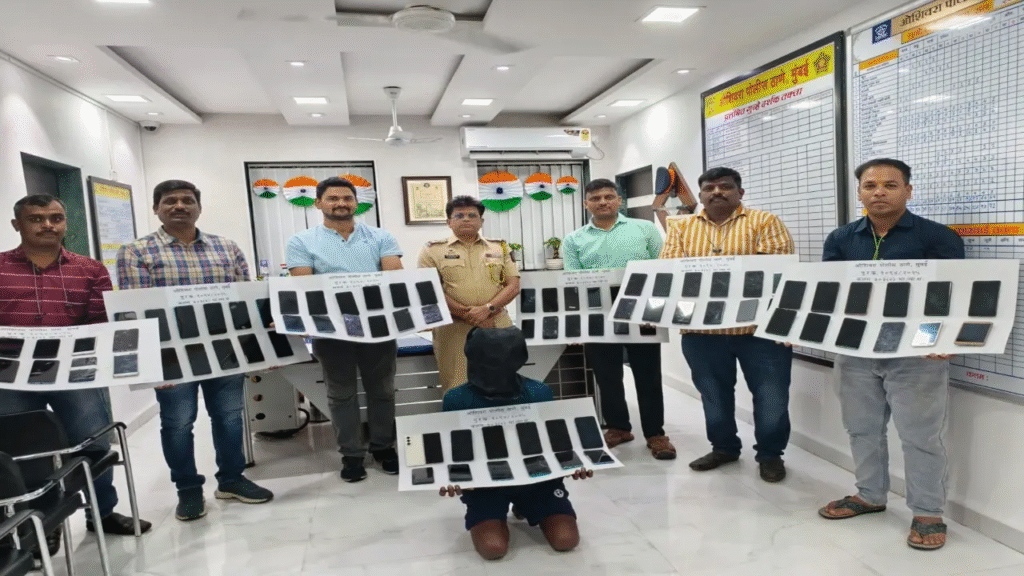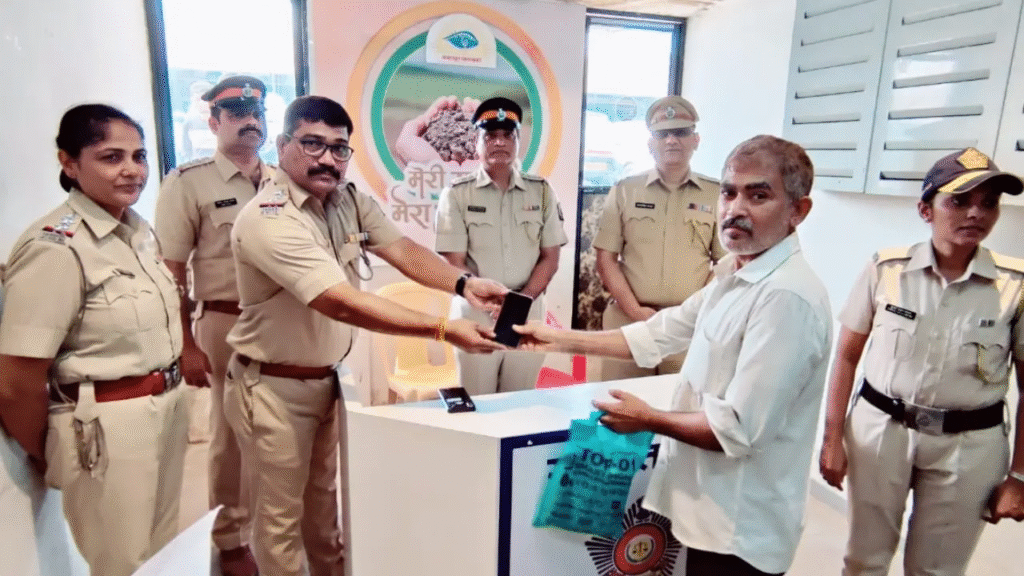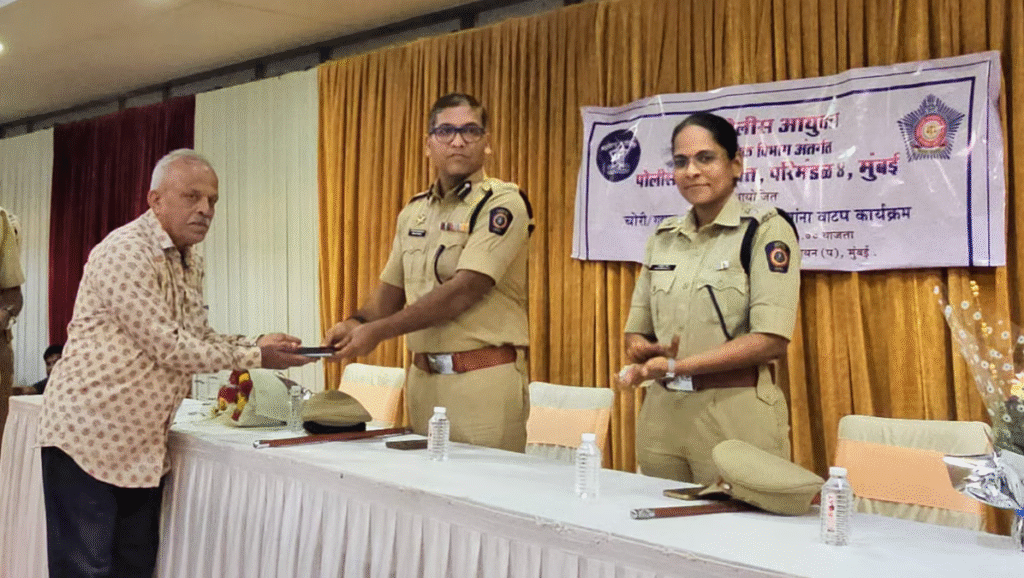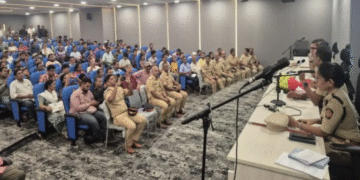In a major recovery operation, Mumbai Police tracked down 1,464 stolen and lost mobile phones worth ₹3.22 crore and returned them to their rightful owners, showcasing swift and effective action
In a significant operation, Mumbai Police has recovered 1,464 mobile phones — either stolen or lost — valued at approximately ₹3.22 crore. In a gesture of public service and goodwill, these phones were handed back to their rightful owners in a coordinated “return” drive across several zones in the city.
The operation underscores the effectiveness of coordinated policing, use of technology (notably CEIR / IMEI tracing), and public trust-building efforts. But beyond the numbers, it opens up questions about the scale of thefts, challenges in recovery, and expectations from law enforcement in a megacity like Mumbai.
Operation Breakdown: How It Was Done

Zones & Coverage
The recovery and return drive involved Zones 3, 4, and 5 of Mumbai. These zones include many densely populated and high‑footfall localities, where mobile thefts or losses are common.
Here is the breakdown of phone recoveries by zone and area:
- Zone 3 — 356 phones
- Tardeo: 62
- Nagpada: 80
- Agripada: 48
- Byculla: 61
- Worli: 55
- N. M. Joshi Marg: 50
- Zone 4 — 448 phones
- Bhoiwada: 72
- Kalachowki: 48
- Matunga: 79
- R. A. K. Marg: 58
- Sion: 69
- Antop Hill: 61
- Wadala T.T.: 61
- Zone 5 — 660 phones
- Dadar: 138
- Shivaji Park: 113
- Mahim: 88
- Shahunagar: 70
- Dharavi: 97
- Kurla: 108
- V. B. A. Nagar: 46
In addition to the phones, other recovered items such as gold, silver, and precious metal ornaments worth ₹21.87 lakh were also returned.
Tech & Policing Tools Involved
A major enabler in this effort was the CEIR (Central Equipment Identity Register) portal, which helps track mobile phones through their IMEI numbers — even when they are moved across states. Mumbai Police cyber units, crime detection teams, and CEIR operators were all engaged in the process.
Police have been increasingly making mobile returning functions part of their regular operations. Many local stations now hold periodic “return drives,” where phones already recovered are handed back after ownership verification.
Since June 18, Mumbai Police has prioritized returning stolen mobile phones, and in the span from June to August 2025, over 8,000 mobile phones were returned in various parts of the city.
Moreover, stations sometimes see people dropping off phones they found “by mistake,” which are later matched to lost/stolen‑phone records.
Why This Matters & What It Reflects

Scale of the Problem
The fact that such large numbers of phones are lost or stolen is not surprising in a mega-urban environment like Mumbai. Theft, snatchings, pickpocketing in crowded trains/buses, and misplacements in public spaces are common.
Recovery numbers like 1,464 in one drive mean that crime detection, tracing, and inter-zonal coordination are reaching a scale to match the crime. But it also reflects that many phones are still in circulation outside the system.
Restoring Public Trust & Police Reputation
Returning phones is not just a crime-fighting success but a trust-building exercise. Citizens often feel aggrieved when theft occurs and the culprits remain at large. The police returning their property — even after delays — sends a message of responsiveness and accountability.
The “mobile returning functions” also help change the perception that police only act when forced — here they are taking initiative.
Deterrence & Messaging
Such large recoveries send a signal to organized phone theft networks that police are improving detection capabilities. The use of IMEI tracking, cross-zone coordination, and cyber policing can raise the risk for perpetrators.
For everyday people, awareness increases that lost/stolen phones may be recoverable, which could encourage more FIR filings, better retention of IMEI records, and cooperation with authorities.
Challenges & Limitations
- Ownership Verification & Privacy
Handing back phones requires verifying claimant identity, cross-matching IMEI, checking whether the device is in a legal chain, ensuring it’s not hot‑wired or reprogrammed. That can be resource-intensive and prone to delays. - Time Lags & Usage in Other States
Many phones, once stolen, are moved across states. Even with CEIR, tracing them when they pass through multiple jurisdictions complicates recovery. - Parts Dismantling & Component Sales
Some thieves strip parts (camera modules, screens, batteries) and sell them separately, making the phone irrecoverable as a whole. Others reprogram IMEIs illegally. - False Claims & Disputes
There can be disputes among claimants, mistaken claims, or fraud attempts. Ensuring fairness and avoiding wrongful returns is another layer of complexity. - Resource Constraints
Cyber units, manpower, forensic support, legal procedures — scaling these to processes for thousands of phones is heavy work. - Public Awareness & Reporting
To recover, the phone must be reported lost or stolen (FIR or “e-lost” report), and IMEI must be recorded. Many people fail to do so, reducing the effectiveness of recovery initiatives.
Human Angle: Stories Behind the Devices

While big numbers highlight the scale, each phone means a person — someone losing personal data, memories, contacts, work tools, etc. For many, the safe return is deeply emotional.
In past drives, recipients have expressed relief at getting back devices with photos, messages, documents. Some take hours to set up screen locks or verify identity; many admit they had little hope.
These stories matter in public communication: showing the human side of police recovery helps bridge the gap between enforcement and citizen trust.
What Mumbai Citizens Should Know & Do
- Always note and securely store your phone’s IMEI (found via *#06#).
- If your phone is lost or stolen, report it immediately with FIR / e‑lost, including the IMEI.
- Cooperate with police and provide proof of ownership (bill, box, accessories).
- Monitor CEIR / telecom apps for tracking.
- Don’t buy second-hand phones without proper bills or IMEI checks — you risk buying stolen units.
- Be aware of police “mobile returning functions” in your local jurisdiction.
- Back up data often so loss isn’t total.
Comparisons & Trends in India
- In a smaller timeframe, Mumbai Police recovered 347 lost and stolen phones worth ~₹56 lakh in a 15‑day drive in one zone.
- In Mumbai between September 2019 and June 2025, over 12,109 mobile phones were recovered citywide.
- Other cities are also using CEIR-enabled recovery: e.g. Navi Mumbai Police returned 122 phones worth ~₹25 lakh.
These numbers suggest a rising trend in proactive recovery and return initiatives across Maharashtra and major metros.
What to Watch Going Forward
- Expansion to More Zones
Will the drive extend to Zones 1, 2, 6, 7, 8? Citywide coverage will be key. - Faster Turnaround
Reducing time between recovery and return improves public satisfaction. - Inter-State Coordination
Strengthening agreements with police in other states to recover devices moved across boundaries. - Legal & Policy Support
Possible policy changes to make IMEI tampering a stricter offense, faster judicial frameworks to support returns. - Technology Upgrades
Better integrations between CEIR, telecom operators, and police apps; real-time alerts for recovered devices. - Public Awareness Campaigns
Push for more citizens to register IMEIs, file reports, and not buy suspect phones.
Also Read : Hrithik Roshan to Nora Fatehi: Celebs Bring the Sparkle to Ramesh Taurani’s Diwali Celebration















 Categories
Categories









